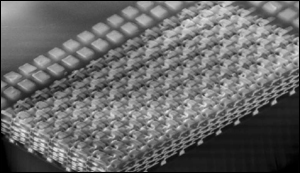Three-Dimensional Neural Networks
4. 5. 2020 | University of Massachusetts | www.massachusetts.edu
Researchers at the University of Massachusetts and the Air Force Research Laboratory Information Directorate have recently created a 3-D computing circuit that could be used to map and implement complex machine learning algorithms, such convolutional neural networks (CNNs). This 3-D circuit, presented in a paper published in Nature Electronics, comprises eight layers of memristors; electrical components that regulate the electrical current flowing in a circuit and directly implement neural network weights in hardware.
"Previously, we developed a very reliable memristive device that meets most requirements of in-memory computing for artificial neural networks, integrated the devices into large 2-D arrays and demonstrated a wide variety of machine intelligence applications," Prof. Qiangfei Xia, one of the researchers who carried out the study, told TechXplore. "In our recent study, we decided to extend it to the third dimension, exploring the benefit of a rich connectivity in a 3-D neural network."

"The fully connected topology of almost all existing memristor devices does not match the complex topologies of modern neural networks, such as CNNs, the most prominent computational techniques currently used for computer vision applications," Lin explained. "As a result, efficient implementation of a convolutional neural network in a memristor system becomes extremely challenging."
Read more at University of Massachusetts
Image Credit: University of Massachusetts
-jk-




